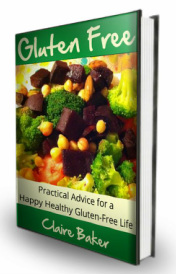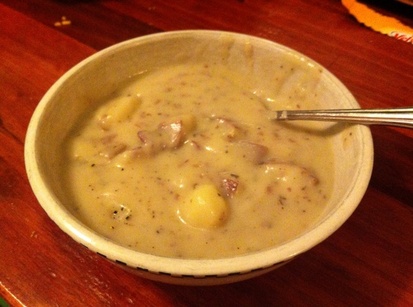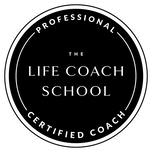 We humans are hardwired to be in a constant state of dissatisfaction. What we have is never enough. Once we attain something, we want something else. This design of constant craving clearly had evolutionary advantages. Imagine being a long-past hunter-gatherer who was truly present in the moment and grateful for her current state of abundance one summer. Come winter, her peers who felt they never had enough would have socked in loads of extras, while she would have missed the opportunity to stock up during the time of plentitude. This trait of always wanting is connected to how our bodies are wired to not feel full until 20 minutes after we are sated. Why in the world would we have evolved to overeat if not to take advantage of food while it was available even if it was more than we needed at that moment in time? These days, we experience this aspect of evolution as dissatisfaction, which doesn't necessarily have to be a bad thing. It can give us the drive or motivation to make positive changes. Even if things in our lives are going pretty well, we're always wanting something to be different. Whether it is food or material positions or work or family, it is very hard for us to be content with what we've got. I gave some tips for creating successful New Year’s resolutions in my December newsletter. (Check it out here, and be sure to sign up for my mailing list so that you won’t miss a single issue of future editions!) For today’s post, I want to offer a few other thoughts about living the life you deserve. We all just want to be happy. All of our striving for whatever it is that we think we want is because we think it will take us one step closer to being happy. Consider the following as stepping stones on your journey to the life you want to be living. Have and hold the vision. What do you want your future life to look and feel like? What will you be doing? With whom? How will it make you feel? You need to know where you are headed before you can set out on the road to get there. Focus on what you want, not what you don’t want. For example, for your future self say “I am fit and healthy,” and not “I’m not sick and tired anymore.” We get what we focus on, so keep it positive. Money won’t make you happy. Research shows that lottery winners revert to their former level of happiness within a year’s time. Focus on a vision of your future self that is about how you feel, not about what you have. It’s about flow and meaning too. Research also shows that in addition to having a pleasant and fun life, you also need to have activities that challenge and absorb you (called flow), and you need to feel like you are making a difference in the world. Figure out what gives you flow and where you feel you can contribute to the greater good, and make time for these activities on a regular basis. Take inspired action. Now that you have the vision of your future self, set out on the path of making the vision a reality. Keep your eyes open for possibilities. You never know when you might meet your next collaborator or find your next source of inspiration. Make time for gratitude. This one is surprisingly hard for me to remember. Take time to appreciate all of the good things in your life right now. Happiness happens in the present, and being grateful for what you’ve got right now can buoy you and carry you along on your journey. [Sign up for the mailing list to get Gluten Free: Practical Advice for a Happy, Healthy and Gluten-Free Life, plus the monthly newsletter and other updates, offerings, tips and more! (I never sell or share my mailing list.)] I have been feeling very out of whack since I learned of the tragedy at Sandy Hook Elementary. I have two sons, ages 9 and 11, and I can barely bring myself to think about those kids, the teachers and staff, the parents and the community. There isn't really a way for me to directly offer support, solace or comfort, which makes me feel helpless. Over the last couple of days, I have had some learnings about what to do and not to do to help myself and my family cope.
1. It's okay to not feel bad every minute. I'm glad the boys and I went to the gluten-free meetup and cookie swap on Saturday. The baking beforehand was enjoyable and productive and I got to spend some time with my 9-year-old making chocolate peppermint cookies. The party itself was very fun. 2. No matter how good all the gluten-free cookies left over from the party are, too much sugar sends me to a rather bleak place. I need to remember that sometimes its easier to eat none than think I can just eat one, which I usually can't. 3. Say yes to interaction and people. Too much screen time or alone time makes it harder for me to pull out of a tailspin. I really wish I had said yes to a game of Apples to Apples with my kids yesterday. 4. Make healthy comfort food. I made my mom's pea soup for dinner. Sometimes you just need your mom. 5. Remember what it's like to be a kid. My boys are troubled by what happened too, but they don't really have the verbal or emotional vocabulary to express it. For the first time in a long time, we all piled in bed together last night. I think it helped all of us. 6. Get some exercise. Even though it's cold and rainy/foggy this morning, my half hour run was a sanity-saver, a moving meditation, that helped me find my emotional bearings. 7. Write. Being able to put your thoughts down on paper is like sharing a burden so that you don't have to carry a heavy load around with you all the time. 8. Listen to music. I've been alternating Charlotte Church and Julia Fordham and October Project on Pandora. It helps. 9. Appreciate EVERYTHING. Tell your family you love them. Watch the sunrise. Look at pictures of happy times. Savor your morning coffee. 10. Convey gratitude. Thank those people who have loved and supported you and kept you safe. Write them a letter. Tell them. Even if they are no longer with us, trust that the effort you put into thanking them will boost the positive energetic vibration that we all occupy. Peace be with you, today and always.  It's finally ready! I'll be adding my new ebook Gluten Free: Practical Advice for a Happy, Healthy and Gluten-Free Life, to my ecookbooklet at the Kindle store at Amazon soon, but for now I want to start getting it out there! Subscribe to So What CAN You Eat? and get the pdf of the book for free! (I never share or sell my list!) And let me know what you think. As always, thanks for all your support.  I created this remarkably tasty soup in about a half an hour. Jenn describes it as rich and fitting for the season. It was also incredibly filling. You may be wondering where the greens are. After all, it is rare that I would create a soup or stew and not sneak some nutrition-boosting kale or spinach in there somewhere. Believe it or not, I was out. I know, right? Jenn was at the grocery store and would have been home with them before long, but I wanted to have dinner on the table when she got back, so I decided to forgo them this time. I'm sure the soup would have been equally delicious with a bunch of greens thrown in. The only thing I wish I'd done differently was to double the recipe so that I'd have had some leftovers! 3 medium-to-large red skinned potatoes (I hate peeling potatoes so I leave the skins on) 1 small onion 1 tablespoon olive oil 1 cup vegetable broth 1 tablespoon dried sage 1/4 teaspoon black pepper 1/2 teaspoon salt 1 tablespoon nutritional yeast 1 1/4 plain unsweetened almond milk Wash and cut up the potatoes in bite-sized chunks. Throw them in a medium soup pot, cover with water and boil them for 8-12 minutes, until they pierce easily with a fork. (You can also just start with cooked potatoes, or microwave them or otherwise come to make them be not raw.) Once the potatoes are tender, drain them in a colander. Use the same pot for the next steps to save yourself some dishes. While the potatoes are boiling, chop the onion. Once the potatoes are out of the pot, saute the onion in a little olive oil on medium heat for a few minutes until tender. Add the broth, sage, pepper, salt and 2/3's of the potatoes. Bring to a boil and cook for about 5 minutes. Turn off the heat. Use a stick blender to puree the contents of the pot. Alternatively, pour the contents of the pot into a blender and blend until smooth, then return it to the pot. Add the rest of the potatoes, nutritional yeast, and almond milk. Combine throroughly and heat through. Adjust seasonings to taste. Enjoy it very much and wonder what it would have tasted like if you'd have added a cup or two of frozen spinach at the very end. If you are Jenn and me, this recipe makes 2 servings. In real life, it would probably make 3 or 4, depending on if this is a starter course or the main attraction. [[Sign up for the mailing list to get the monthly newsletter and other updates, offerings, tips and more! (I never sell or share my mailing list.)] |
Archives
January 2024
|


 RSS Feed
RSS Feed
